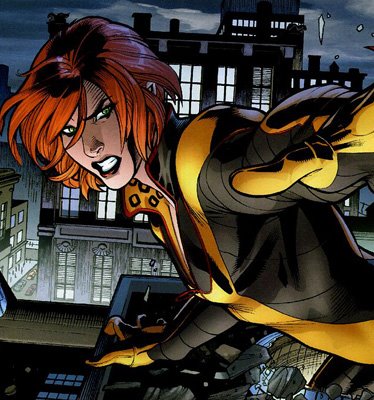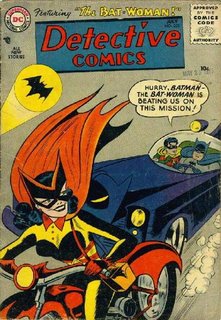Incandescent not only describes my subject, but my mood. It's time to set the rant levels to 11.
I'd start with a few words about writer Judd Winick, but
Ragnell's
got that covered.

Now I'm not sure how much time is supposed to elapse between
Identity Crisis and
Infinite Crisis, but continuity is stretched past breaking point here, so it may get a little confusing. In
Green Arrow #54 Winick writes a story that follows up on events in
Identity Crisis, but in order to fit in with
Infinite Crisis and
52 it
officially occurs during
52 week 2, even though it was published 10 months earlier. Confused yet?
GA #54, the short version: Green Arrow and Black Lightning are looking for evil Doctor Light. Evil Dr. L. is conveniently only a few blocks away attacking Kimiyo Hoshi, the good Doctor Light. Evil Dr. L steals Kimiyo's powers and flies off cackling. Green Arrow finds Kimiyo in the hospital and is attacked by Mirror Master and Killer Frost, and runs off to fight them. Kimiyo is left bleeding on the floor and never seen again.
So what's wrong with this picture?
Well the continuity problems start with Kimiyo being seen in costume in Tokyo during
Infinite Crisis, and then in America in
52 #1, and in flashbacks to around the same time in current issues of
Action Comics. She's actually appeared more in costume using her powers in the last few months than she has in years, except that she was depowered and badly wounded months ago.

And to make it worse, in GA #54 it states quite specifically that she has not used her powers in two years. But then it also has Kimiyo Hoshi, astronomer, scientist, and medical docter who lives in Japan working as a business executive in Star City, America. Something is wrong somewhere and I think it's probably that Judd Winick is a lazy writer who didn't bother to research the character he was planning to destroy.
Winick writes the fight between Light and Kimiyo as entirely one sided, and Evil Dr. L. only wins because Winick ignores Kimiyo's established abilities, and worst of all belittles her character by telling us that she lacks the instinct to understand the situation. Frankly, I don't fully understand the situation.

Winick implies that they have the same powers, but that's nonsense. Although both are light based, their powers are not related in any way. Evil Dr. L got his from technology built into his costume, which he didn't even create; Kimiyo was zapped by The Monitor who channeled the power of a star into her. And even if they were identical, that doesn't mean that one can just take the other's power. It's like saying an athelete could steal another athelete's ability to jump by hitting them. Sure, super villains are always stealing heroes' powers, but there's usually some explanation for how they are doing it. Here there is none.

And then there's the problem that Kimiyo is magnitudes of times more powerful than Evil Dr. L. In Crisis on Infinite Earths she tapped a star to blow a hole in the Anti-Monitor. Although nobody bothered to write her at this level of power in later years, for raw power output she is in the Superman class. And unlike Evil Dr. L. she has been shown to tap other sources to boost her levels. There is evidence to support
her taking
his power, but not vice versa.

Once Evil Dr. L has "stolen" her powers, we only get one more scene with Kimiyo. Green Arrow bursts into the hospital room where she is lying bandaged, with an oxygen mask over her face. She gets to deliver a message to GA from Evil Dr. L. that it is a trap, so that the villains can make a dramatic entrance. GA goes chasing after them and Kimiyo is left lying there, never to be seen again (not counting the many "flashbacks" that have appeared since). She gets no resolution to her story, no cathartic revenge on her abuser, not even an indication whether she survived the experience.
She didn't even get one of those little tag scenes you'd get at the end of the A-Team, where Hannibal would say "Well, Mary-Anne, your father and brothers may have been murdered and your family business burned down, but we brought their killers to justice so it's all better." And then they'd all have a big laugh and Face would hit on her.

But that's not the end of it.
Green Arrow eventually confronts evil Dr. L in GA #57, and Winick gives Light several pages to expound on the joys of being a rapist. He likens his attack on Kimiyo to rape "only more benefitting than usual." And having painted this character as the most vile abuser, Winick allows him to escape. Evil Dr. Light leaves the story without any kind of censure. Kimiyo gets no justice; her abuser who considers himself her rapist gets to walk free.


And I'd just like to mention that the only other female in the story, Mia, also gets badly wounded by evil Dr. Light and left for dead. Green Arrow is apparently badly injured right at the end of the story (not by EDL), but since he has bounced back by the following issue, it's not really the same. I don't know if Mia has been seen since she got shot and blown up by EDL but there was no mention of her in the two subsequent issues of GA I read.
To say that Kimiyo was badly written in this story is understatement. Her background details are arbitarily changed to fit the story Winick wants to tell, and the only reason she's in it at all seems to be to power up the villain and make him look even nastier than he was already (because being revealed as a rapist in Identity Crisis clearly wasn't enough). Once her purpose is served she is dropped from the story like a used tissue, and the fact that her story gets no resolution just shows how little Winick cares.

Is this the end of the road for Kimiyo Hoshi? With all of her subsequent "flashback" appearances one can hope not. It would be a sad and pathetic way to go out, symbolically raped and left to die, forgotten, while her abuser escapes cheerfully singing a happy little song, our last sight of her the back of her head in a flashback, or her broken body lying on the floor.

I'm keeping my fingers crossed.
















































